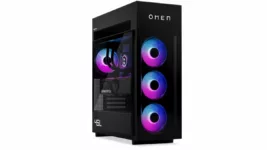For years, the high-end, pre-built gaming PC market was a kingdom ruled by one name: Alienware. Dell’s acquisition of the boutique builder in 2006 cemented its dominance, creating a powerful brand synonymous with premium gaming. But in the tech world, no dynasty lasts forever. A lack of focus on user-centric design and a preference for monolithic, difficult-to-upgrade systems created an opening. Now, a challenger has risen, and it’s a name once more associated with printers and business laptops: HP. Through a combination of thoughtful design, strategic acquisitions and a willingness to listen to gamers, HP’s Omen line, particularly the new flagship version Omen 45L, is not just competing; it’s starting to pull ahead.
A Legacy of Design and a Stroke of Genius
HP’s commitment to design in the gaming space isn’t new. The Omen brand itself is a direct descendant of VoodooPC, a high-end custom PC builder HP acquired in 2006, right around the same time Dell bought Alienware. This pedigree of boutique, gamer-focused design has been slowly cultivated within HP. This commitment to aesthetics and function is now fully realized in Omen 45L.
The most striking and innovative feature of Omen 45L is its patented OMEN Cryo Chamber. This is a masterclass in thermal engineering. Instead of mounting the CPU’s liquid cooling radiator inside the main chassis where it would be inundated with hot air from the GPU and other components, HP has elevated it into a separate, isolated compartment at the top of the case. This allows the radiator to draw in cool, ambient air, significantly lowering CPU temperatures. The result is a system that runs cooler and quieter and can sustain higher performance for longer periods. It’s a simple yet brilliant solution to a problem that has plagued PC builders for years.
This thoughtful approach stands in stark contrast to Alienware’s recent design philosophy. For years, Alienware has been criticized for its beautiful but often restrictive and proprietary case designs. These systems, while visually stunning, often suffer from poor airflow and are notoriously difficult to upgrade, locking users into Dell’s ecosystem. HP, on the other hand, has embraced the DIY spirit by using industry-standard parts and a tool-less design that invites users to tinker and upgrade, respecting the very essence of PC gaming.
Building a Gaming Ecosystem
HP’s strategy extends beyond the box itself. Its acquisition of HyperX from Kingston in 2021 was a clear signal of HP’s intent to build a complete gaming ecosystem. HyperX has a stellar reputation for high-quality headsets, keyboards and mice. By integrating this beloved peripherals brand into the Omen family, HP can now offer a seamless, high-quality experience from the PC to the peripherals, all managed through the OMEN Gaming Hub software. This holistic approach is something Dell has struggled to achieve, with its peripherals often feeling like an afterthought.
The Future of the Gaming Desktop
So, where does the gaming desktop go from here? By 2030, we can expect a few key evolutionary paths. The trend toward smarter thermal management as pioneered by the Omen 45L will become standard. We’ll likely see more systems with modular cooling solutions and AI-driven fan and power management. The monolithic, hard-to-upgrade designs will become a niche product for those who value aesthetics above all else.
The future of gaming will be heavily influenced by cloud and AI. While local processing power will still be crucial, we’ll see tighter integration with cloud services for things like AI-powered NPC behavior, procedural content generation, and even offloading some rendering tasks. Gaming desktops will become hybrid devices, seamlessly blending local and cloud processing to deliver experiences far beyond what is possible today. We can also expect more immersive experiences with advancements in AR and VR, and gaming desktops will be the powerhouse driving these new realities.
Wrapping Up
HP’s resurgence in the gaming space is a testament to a long-term strategy focused on smart design, user feedback and strategic acquisitions. The Omen 45L, with its brilliant Cryo Chamber and open, upgradable design, is a clear shot across the bow of the competition. It proves that a major OEM can build a PC that appeals to both casual gamers and hardcore enthusiasts. This is particularly relevant as Intel, a key partner for both HP and Dell, navigates its own comeback. Intel’s success with its next-generation processors will be crucial for powering the gaming desktops of the future. As long as Intel continues to deliver the performance that gamers demand, companies like HP will be there to build the innovative systems that house them. The battle for the gaming PC crown is far from over, but for the first time in a long time, there’s a real fight, and that’s a win for all gamers.








